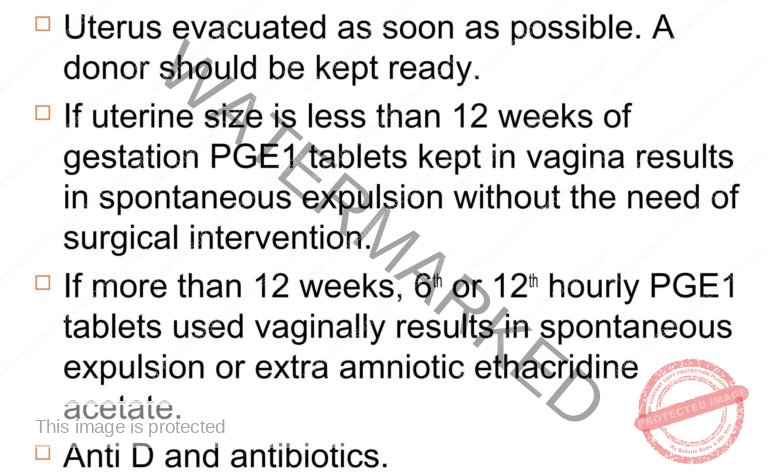Abortion
Subtopic:
Missed abortion

A missed abortion is diagnosed when an embryo or fetus ceases to live or stops developing, but the pregnancy tissue remains inside the uterus for an extended period, potentially weeks or even months.
Essentially, in a missed abortion, fetal demise happens, yet the body does not expel the pregnancy.
Typically, the embryo stops developing before the gestational age of 8 weeks is reached.
Often, the disappearance of pregnancy symptoms will cause a woman to seek medical evaluation. These symptoms may include: vaginal bleeding, pain in the abdomen, brownish discharge from the vagina. Upon examination, the cervix is typically found to be closed.
Clinical Features of Missed Abortion
Menstrual History: A history of a missed menstrual period (amenorrhea) is usually present.
Initial Pregnancy Symptoms Fade: Symptoms that initially suggested a threatened abortion may have been present but then subsided or disappeared.
Lack of Expected Pregnancy Signs: The typical signs of a progressing pregnancy are absent upon examination.
Breast Changes Reverse: The breasts may become smaller, reversing the changes typically associated with pregnancy.
Uterine Size Not Progressing: The uterus does not grow as expected for the gestational age, indicating the fetus is not developing.
Products of Conception Detached, Not Expelled: The pregnancy tissue separates completely from the uterine walls but is not expelled from the body.
Cervical Status: The cervix remains tightly closed.
Later Symptoms: After some weeks, a brownish vaginal discharge might precede further bleeding, lower abdominal discomfort, and the eventual expulsion of a reddish-brown mass of tissue.

Management of Missed Abortion
Initial Steps at the Maternity Center:
Arrange Hospital Transfer: The primary action is to organize transportation for the patient to a hospital setting where comprehensive management can be provided.
Preliminary Assessment: While awaiting transport, gather the patient’s medical history and perform a basic physical examination to document initial findings.
Referral Documentation: Send the patient to the hospital accompanied by a written referral note summarizing the patient’s condition and the actions taken at the maternity center.
Hospital Management:
Hospital Admission: Upon arrival, admit the patient to a gynecology service within the hospital.
Induction of Uterine Emptying (if needed): If the body does not naturally expel the pregnancy tissue, medications like prostaglandins or oxytocin may be administered intravenously to stimulate uterine contractions and facilitate expulsion. These medications help to initiate labor-like processes in the uterus.
Surgical Uterine Evacuation (if necessary): If medication is not effective or if immediate evacuation is required, a surgical procedure using suction curettage may be performed. This involves gently dilating the cervix and then using suction to carefully remove the pregnancy tissue from the uterus.
Pain Management: Provide pain relief medication (analgesics) to manage any discomfort or pain experienced by the patient during the process.
Vital Signs Monitoring: Regularly monitor and record the patient’s vital signs, including temperature, pulse rate, respiratory rate, and blood pressure, to assess their overall condition and response to treatment.
Get in Touch
(+256) 790 036 252
(+256) 748 324 644
Info@nursesonlinediscussion.com
Kampala ,Uganda
© 2025 Nurses online discussion. All Rights Reserved Design & Developed by Opensigma.co

